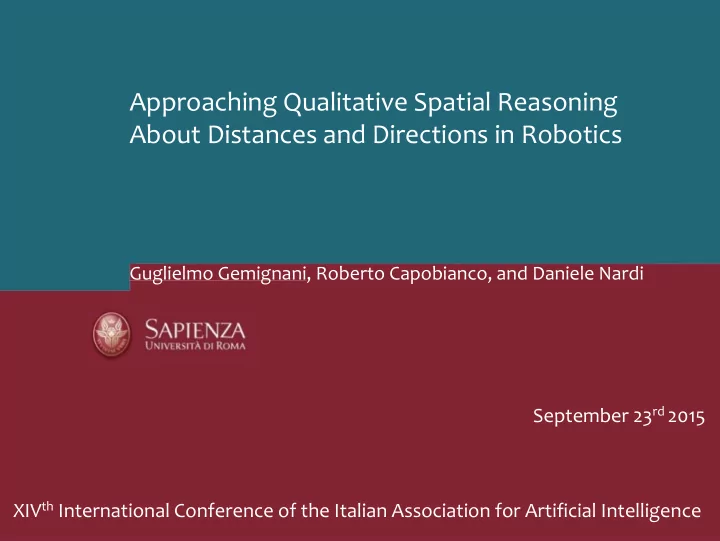

Approaching Qualitative Spatial Reasoning About Distances and Directions in Robotics Guglielmo Gemignani, Roberto Capobianco, and Daniele Nardi September 23 rd 2015 XIV th International Conference of the Italian Association for Artificial Intelligence
Interacting With Robots Multiple works have considered robots able to take vocal commands from humans Approaching Qualitative Spatial Reasoning About Distances and Directions in Robotics
Our Robot Semantic Map acquired during the First Örebro Winter School on "Artificial Intelligence and Robotics" Approaching Qualitative Spatial Reasoning About Distances and Directions in Robotics
Considered Problem Tasks given to mobile robots often consist of reaching certain positions These locations are often described by an object nearby (e.g., go to the fridge to get a coke, or go to someone’s desk to deliver an object). What if you tell the robot to go in front of an object and the robot knows multiple instances of such an object? Approaching Qualitative Spatial Reasoning About Distances and Directions in Robotics
Example Assume we need to tell a robot to go in front of a plug in order to charge it Assume that we have a particular plug in mind since the robot should not be in the way while charging How could we distinguish the plugs? We propose to use objects’ spatial properties Approaching Qualitative Spatial Reasoning About Distances and Directions in Robotics
Grounding Commands Vocal commands are grounded in the robot KB The grounding step might fail We allow the user to specify objects based on their spatial relations with another object (e.g., “go to the socket on the right of the closet”) Approaching Qualitative Spatial Reasoning About Distances and Directions in Robotics
Spatial Reasoner Approaching Qualitative Spatial Reasoning About Distances and Directions in Robotics
Cone-Based Reasoner Approaching Qualitative Spatial Reasoning About Distances and Directions in Robotics
Conclusion Experiments show that our approach allows the robot to effectively ground previously ambigous commands We can now disambiguate using 2D spatial relations. For the future, what about 3D? Approaching Qualitative Spatial Reasoning About Distances and Directions in Robotics
Recommend
More recommend